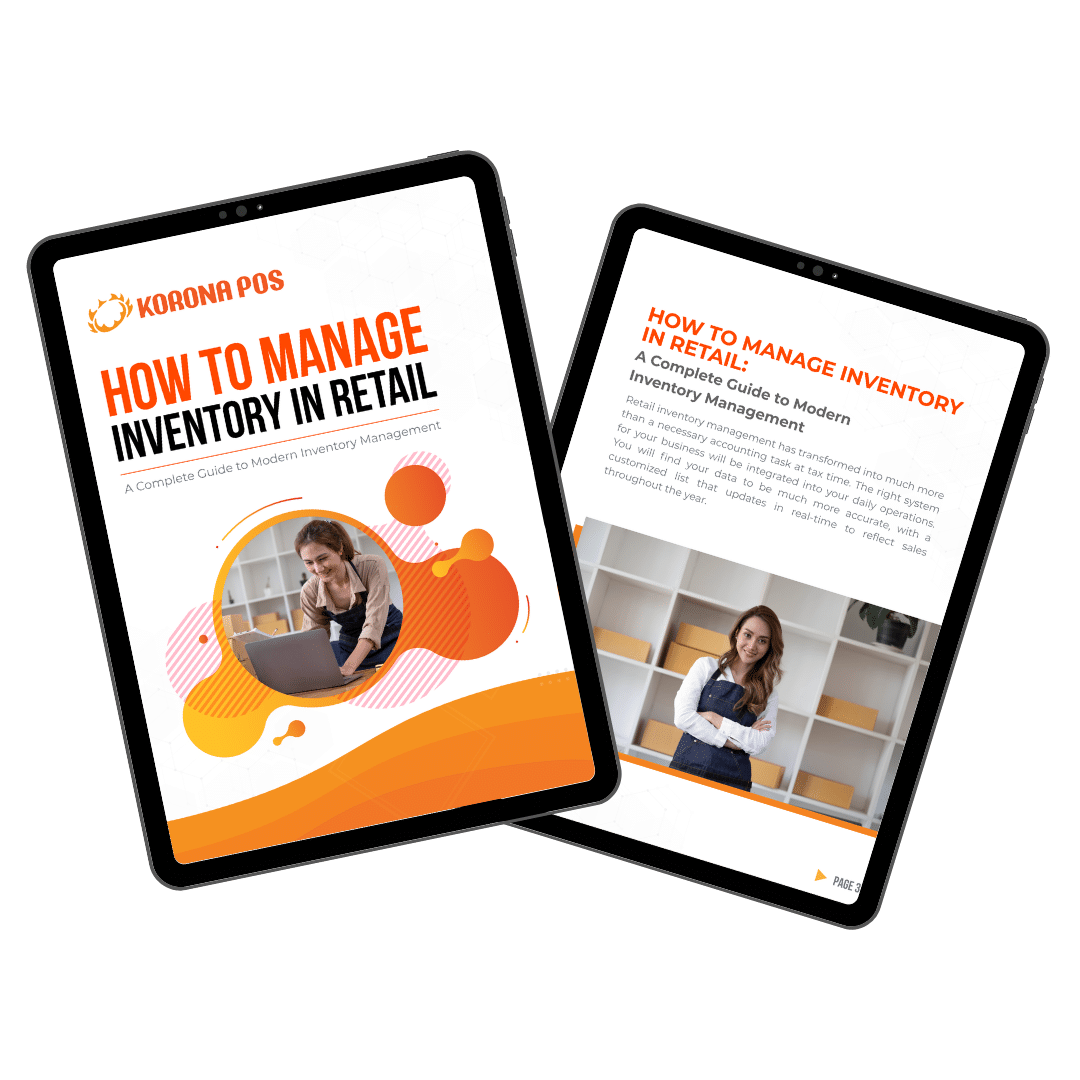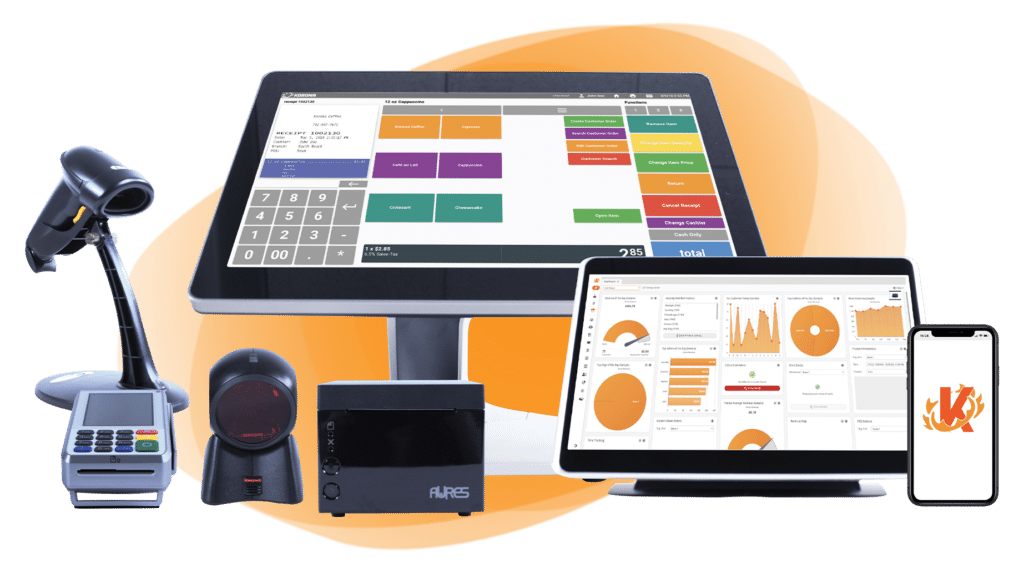💡 Key Takeaways:
- 🎁 Stock Unique Products: Offer distinctive, locally-inspired gifts to differentiate from competitors.
- 📱 Boost Digital Presence: Use social media contests and SEO to attract gift shoppers.
- 📍 Pick Prime Location: Select high-traffic spots with strong visibility and access.
- 🤝 Personalize Shopping: Provide curated gift categories and tailored customer engagement.
- ⚙️ Streamline Operations: Implement POS systems and inventory tools for efficiency.
- 🎉 Host Community Events: Organize workshops or gift fairs to draw crowds and build loyalty.
- 🌿 Embrace Sustainability: Use eco-friendly packaging and products to appeal to conscious buyers.
To run a successful gift shop in 2025, you need a strong online presence, a well-defined niche, automated inventory management, and modern tools like KORONA POS to streamline operations.
If you’ve been struggling with rising costs, slow sales, or juggling in-store and online orders, you’re not alone, and you’re in the right place. In this guide, we’ll show you exactly how to set up, manage, and grow your gift shop.
You’ll learn how to choose winning products, attract loyal customers, and simplify your daily operations. Let’s get started.
How to Open a Gift Shop?
Find below the essential steps to open your gift shop:
1. Define Your Concept and Target Audience
First, decide what type of gift shop you want to open. Will you focus on:
- Artisanal/handmade items
- Home décor gifts
- Specialty items (like candles or stationery)
- Local/regional products
- Seasonal gifts
- Personalized gifts
2. Research the Market
- Visit other gift shops in your area to understand what’s already available
- Identify potential gaps in the market that your shop could fill
- Talk to potential customers about what they’d like to see
- Research gift industry trends and forecasts
3. Handle Legal Requirements
- Register your business name
- Choose a business structure (sole proprietorship, LLC, etc.)
- Obtain necessary licenses and permits
- Get a tax ID number
- Set up business banking
- Arrange for business insurance
4. Secure Funding
Calculate your startup costs, including:
- Rent deposit and the first few months’ rent
- Renovation/build-out costs
- Initial inventory
- Fixtures and equipment
- Marketing expenses
- Operating capital for the first 6-12 months
5. Find the Right Location
For a brick-and-mortar shop:
- Choose an area with good foot traffic
- Consider nearby complementary businesses
- Ensure adequate parking and accessibility
- Check zoning regulations
- Negotiate a favorable lease
6. Source Your Inventory
- Attend gift trade shows and markets
- Connect with wholesale suppliers
- Find unique local artisans and makers
- Consider consignment arrangements
- Order enough variety to create an enjoyable shopping experience without overextending your budget

7. Design Your Store
- Create an inviting, browsable layout
- Invest in quality fixtures and displays
- Design eye-catching window displays
- Set up a functional checkout area
- Consider the flow of customer traffic
8. Set Up Systems
- Point of sale system
- Inventory management
- Accounting software
- Customer relationship management
8 Ways to Run a Successful Gift Shop
Standing out in the crowded gift shop market isn’t about luck. It’s about strategy. With the right mix of creativity, innovative marketing, and a unique in-store experience, your shop can thrive in 2025 and beyond. Here’s how to make your gift shop survive and shine.
1. Planning Your Gift Shop
Planning a gift shop in 2025 requires a strategic approach to thrive in a competitive market. Start by defining a unique niche.
Conduct thorough market research to understand local demand and trends, ensuring your offerings resonate. Choose a high-traffic location or a hybrid online-offline model to maximize reach. Budget carefully, allocating $1,000-$25,000 for inventory, setup, and marketing.
Establish a strong brand identity and integrate technologies to create an engaging, memorable shopping experience that separates your gift shop.
2. Embrace Personalization and Customization
Consumers in 2025 value unique, meaningful gifts. Personalized products create emotional connections and increase perceived value.
Offer customizable products like engraved journals, monogrammed accessories, or bespoke gift hampers tailored to themes.
Use technology like on-site engraving stations or online design tools where customers can preview customizations.
Partner with local artisans for handcrafted, personalized items to support small businesses and add exclusivity.
Consumers are tired of seeing the exact same things in every gift shop. Happily surprise them with trinkets that they will be excited to bring home to family and friends.
3. Prioritize Sustainability and Eco-Conscious Products
Sustainability will be a core consumer value in 2025, and eco-friendly gifts will reflect environmental responsibility. The gift-wrapping market alone is expected to hit $24.9 billion by 2025, with demand for sustainable materials rising. Stock eco-conscious products like reusable stainless-steel drinkware, bamboo gift sets, or items made from recycled materials.
4. Brand Merchandise and Novelty Items
Many gift store products will be branded with designs from nearby attractions and sights. But don’t be afraid to brand yourself with some of your products.
Other products, like t-shirts or other apparel items, might feature a nearby attraction and your retail store’s logo. If you do it right, your gift shop might even become as big a tourist attraction as the attractions surrounding it.
Take some inspiration from Wall-Drug. It started as a gift shop for those going to Mount Rushmore. Business was slow until the owners offered free ice water to tourists traveling across the Midwest in the summer heat. It quickly became a destination in and of itself and now gets over 2 million visitors yearly, nearly as many as its more spectacular neighbor. Here are a few common gift shop products that could easily be branded:
- T-Shirts
- Coffee Mugs
- Water Bottles
- Wristbands
- Koozies
5. Carry Last Minute Essentials
If you have retail space, try stocking your shelves with everyday items. Most tourists travel far from home, often for several days or weeks, and many forget at least one or two of these.
A successful gift shop should be a one-stop shop for those in the area. If accommodations are nearby, you may even be a daily stop for those staying there.
Also, be sure to carry a wide array of snacks and drinks. Vacationing people are more willing to spend money on treats. Depending on the laws and regulations in your location, it might be wise to sell wine and beer or even start a quick-service restaurant on your premises.
Again, find ways to add convenience for tourists in the area. You may get new regulars, even if they’re only regulars for a week.
- Snacks
- Toiletries
- Sunscreen
- Ponchos
- Alcohol and Soft Drinks
- Chargers
- Books and Notebooks
- Cigarettes
6. Get Creative with Your Gift Shop Marketing, Promotions, and Displays
Real estate next to tourist attractions will naturally be higher, so fair pricing is typically slightly more than your average market, but don’t lose new shoppers because of your prices.
One great way to do this is by offering creative bundled deals. People rarely go to a gift store for just one item. Grouping similar items can remind them of what else they need. Adding a discount to these purchases is even better.
Keep your displays fresh and clean across the retail space. Spice up the display areas with new designs, products, and colors. Ask your staff for help with this.
7. Manage Costs and Inventory Efficiently
Source inventory from diverse suppliers (e.g., trade shows, wholesalers, or direct from manufacturers) to get the best value. Use energy-efficient lighting and negotiate with vendors to reduce operational costs. Implement inventory management software to track stock levels and avoid overstocking.
Most items should be cycled through seasonally: stock your shelves with more hoodies and beanies during the winter, and sell ice cream and frozen drinks during the hot summer months.
Try to mix up products in other ways, too. A/B test a select array of items to see which sells better at different times or in various areas of your store. Use your inventory management tools to identify each product’s performance better.
Inventory management a headache?
KORONA POS makes stock control easy. Automate tasks, generate custom reports, and learn how to improve your business.
8. Leverage the Right POS System
Like any modern retail store, integrating technology into your store is a must. While loyalty programs and customer resource management tools might not be as critical for your business type, you need solid inventory management, sales reporting, and product analytics.
These should all be in your gift shop POS system, along with retail metrics like revenue, gross and net margins, sales conversions, etc. Understanding the essential components of a retail POS kit is crucial for those looking to run a gift shop.
Adding mobile gift store POS tablets can improve the customer experience by making the checkout process more convenient and keeping your lines fast and short.

Build Your Own POS
Whether you run a retail store, café, or admissions booth, we have the point of sale hardware designed for your specific needs. Start building your ideal POS system now.
9. Add Value-Added Services
Providing a few services in addition to your products can push your store to another level. It shows your customers how much you care and how well they are cared for. It will certainly set your gift shop apart from your competitors. Here are a few ideas for services you might be able to offer:
- Gift wrapping: Many gift shop customers buy small items for people back home. Provide a simple gift-wrapping station or have a staff member offer wrapping services.
- Coffee and Pastries: Even a small cafe with coffee will go a long way. Most adults need it every morning; traveling and having a lot to see is all about convenience. If you have the retail space, a small cafe and/or bakery might be a great option.
- Tour Info or Guides: Think about partnering with other local tourism businesses. Offer to promote different destinations or tour guide agencies. Perhaps you might want to offer tours yourself. This can be a fun way to interact with guests more deeply.
- Tickets: Many gift shops sell tickets for local attractions. It’s even better if you can offer a slight discount on tickets.
- Events or Presentations: Show off how much you love the area where you live and work by educating your guests on its history and culture. Try hosting relevant events in your retail space.
10. Legal & Setup Basics
Compliance ensures your business operates legally and avoids costly penalties. Obtain necessary permits, such as business licenses, sales tax permits, and local zoning approvals. If selling online, comply with e-commerce regulations like GDPR for customer data protection.
Can I Run an Online Gift Shop?
You can run an online gift shop with a clear plan and the right tools. With the growth of eCommerce platforms like Shopify, Etsy, and WooCommerce, launching an online store has become more accessible than ever.
You’ll need to identify a niche, whether it’s personalized gifts, eco-friendly items, or handmade crafts.
Then, you’ll need to source or create products, set up a website, and market your shop through social media, email campaigns, and SEO. Success requires good customer service, effective branding, and inventory management.
How to Run an Online Gift Shop
Starting an online gift shop can be both fun and profitable. Here’s a quick guide:
- Choose a Niche: Focus on unique gifts (e.g., handmade, personalized, eco-friendly).
- Set Up an Online Store: Use platforms like Shopify, Etsy, or WooCommerce.
- Source or Create Products: Partner with suppliers or create your own items.
- Design Your Brand: Build a memorable logo, packaging, and store theme.
- Market Effectively: Use social media, email newsletters, and SEO.
- Offer Great Customer Service: Quick responses, easy returns, and gift wrapping help build loyalty.
Common Mistakes to Avoid When Running a Gift Shop
1. Buying Inventory Based on Personal Taste
Stocking items based on personal preference rather than data leads to unsold products and wasted capital. Use POS data to identify top-performing SKUs, seasonal trends, and customer preferences. Avoid emotional or bulk purchases without supporting metrics.
Discover Advanced Analytics and Custom Reports
Speak with a product specialist and learn how KORONA POS can work for your business.
2. Poor Seasonal Inventory Planning
Failure to prepare for seasonal spikes, like holidays or local events, can result in missed sales and out-of-stock issues. Seasonal inventory should be ordered months in advance, and historical data should guide purchase quantities and timing.
3. Ineffective Store Layout and Merchandising
Poorly organized displays reduce engagement and sales. Avoid clutter and ensure high-margin or best-selling products are placed at eye level or near checkout. Refresh displays regularly and group products by theme, not just category.
4. Not Collecting Customer Emails
Focusing solely on social media while neglecting email list building limits retention. Emails outperform social posts in conversions. Use discounts or giveaways to grow the list, then send targeted campaigns around new arrivals, bundles, or holidays.
5. Lacking a Clear Brand Identity
A gift shop that tries to appeal to everyone often appeals to no one. Without a clear niche or personality, customers may forget the brand. Choose a unique tone, product style, and visual identity, and remain consistent.
6. Underestimating Online Store Quality
An e-commerce site that’s slow, cluttered, or lacks trust signals will suffer poor conversions. Clear navigation, high-quality photos, transparent policies, and multiple payment options are essential. Test the experience across desktop and mobile devices.
7. Ignoring Local Collaboration Opportunities
Failure to partner with nearby businesses, creators, or event organizers means missing out on free traffic and community goodwill. Co-promotions, local product features, and pop-ups enhance visibility and build customer loyalty within the neighborhood.
8. Missing Out on Bundles and Upselling
Selling individual items without offering bundles limits average order value. Curated kits, gift sets, and add-on prompts at checkout simplify decision-making and increase cart totals. Offer premium packaging or gift-wrapping for additional revenue.
9. Tracking Revenue, Not Profit Margins
Focusing on revenue without monitoring profit margins leads to cash flow issues. Use software to track costs and gross margin per product category. Prioritize high-margin items that also have steady turnover and customer demand.
10. Dismissing Customer Feedback
Overlooking customer input creates blind spots in inventory, pricing, and service. Collect feedback through surveys, reviews, or direct questions. Trends in feedback should inform product selection, store layout, and even marketing strategy for better retention.
Simplify Your Gift Shop Management with KORONA POS
Running a gift shop can be overwhelming, but KORONA POS makes it easier. Here are some benefits of using KORONA POS Gift Shop software:
- KORONA POS streamlines gift shop management with powerful features tailored for small retail. Its cloud-based system provides real-time sales and inventory tracking, accessible from any device, ensuring you stay on top of stock levels and trends.
- It provides automated ordering to prevent stockouts, while ABC analytics highlight top performers and items to discontinue. The POS supports fast, contactless payments, including Apple Pay and Android Pay, for quick checkouts.
- KORONA POS offers customizable gift cards and loyalty programs that boost customer retention, with usage tracking for valuable insights.
- It offers employee management, including permissions and shift reports. The software starts at $59/month, and KORONA offers 24/7 support, no contracts, and a free trial—no credit card required.
If you’re interested, sign up for a free trial, and one of our great support members will walk you through a demo of the gift store POS software. Click below to get started with KORONA POS.












